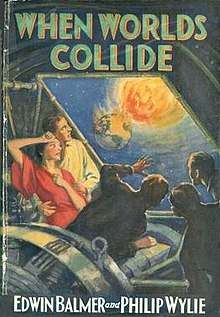When Worlds Collide
When Worlds Collide is a 1933 science fiction novel co-written by Philip Wylie and Edwin Balmer; they also co-authored the sequel After Worlds Collide (1934). It was first published as a six-part monthly serial (September 1932 through February 1933) in Blue Book magazine, illustrated by Joseph Franké.
 First edition published by Frederick A. Stokes | |
| Author | Philip Wylie & Edwin Balmer |
|---|---|
| Country | United States |
| Language | English |
| Genre | Science fiction novel |
| Published | 1933 (Frederick A. Stokes) |
| Media type | Print (hardback & paperback) |
| Pages | 344 pp |
| Followed by | After Worlds Collide |
Synopsis
Sven Bronson, a Swedish astronomer working at an observatory in South Africa, discovers a pair of rogue planets, Bronson Alpha and Bronson Beta, which will soon enter the Solar System. In eight months, they will pass close enough to cause catastrophic damage to the Earth. Sixteen months later, after swinging around the Sun, Bronson Alpha (a gas giant) will return to pulverize the Earth and leave. It is hoped that Bronson Beta (discovered to be Earth-like and potentially habitable) will remain and assume a stable orbit.
Scientists led by Cole Hendron work desperately to build an atomic rocket to transport enough people, animals and equipment to Bronson Beta in an attempt to save the human race. Various countries do the same. The United States evacuates coastal regions in preparation for the first encounter. As the planets approach, observers see through their telescopes cities on Bronson Beta. Tidal waves sweep inland at a height of 750 feet (230 m), volcanic eruptions and earthquakes add to the deadly toll, and the weather runs wild for more than two days. As a token of things to come, Bronson Alpha grazes and destroys the Moon.
Three men take a floatplane to check out conditions across the United States and meet with the President in Hutchinson, Kansas, the temporary capital of the United States. It is discovered that the entire Southeast region flooded, the Great Lakes rose and emptied into the Saint Lawrence region, and Connecticut has become an island archipelago. All three are wounded fighting off a mob at their last stop, but manage to return with a precious sample of an extremely heat-resistant metal one of them had noticed. This solves the last remaining engineering obstacle, as no material had been found before to make rocket tubes capable of withstanding the heat of the atomic exhaust for very long.
Five months before the end, desperate mobs attack the camp, killing over half of Hendron's people before they are defeated. With the rocket tube breakthrough, the survivors are able to build a second, larger ship that can carry everyone left alive (instead of only 100 of the roughly thousand people Hendron had recruited). The two American ships take off, but lose contact with each other. Other ships are seen launching from Europe; the French ship's tubes melt, causing it to explode in the upper atmosphere. The original American ship makes a successful landing, but it is unknown if anyone else made it. The survivors find that Bronson Beta is habitable. They also find a road.
The sequel, After Worlds Collide, details the fate of the survivors on Bronson Beta.
Adaptations and influences
When Worlds Collide had far-reaching influences on the science fiction genre. The themes of an approaching planet threatening the Earth, and an athletic hero, his girlfriend, and a scientist traveling to the new planet by rocket, were used by writer Alex Raymond in his 1934 comic strip Flash Gordon.[1] Jack Williamson's 1934 short story "Born of the Sun" also used the concept of a scientist and his fiancée escaping the destruction of the Earth in a hurriedly constructed "ark of space". The 1940–41 newspaper comic strip Speed Spaulding,[2] an adaptation credited to the novel's authors, was more directly based on the novel. The themes of escape from a doomed planet to a habitable one also can be seen in Jerry Siegel and Joe Shuster's 1938 comic Superman.
The novel was adapted as the 1951 film When Worlds Collide, produced by George Pal and directed by Rudolph Maté.
In 2012, the British composer Nigel Clarke wrote a large-scale work for brass band inspired by the film and likewise titled When Worlds Collide.
See also
- Worlds in Collision by Immanuel Velikovsky (1950)
References
- "Raymond took the basic premise of Philip Wylie's When Worlds Collide, which was being reprinted in Blue Book magazine at the time, and used it as his starting point for adventure". Al Williamson and Peter Poplaski, "Introduction" to Alex Raymond, Flash Gordon: Mongo, the Planet of Doom. Princeton, Wis. : Kitchen Sink Press. 1990. ISBN 0878161147 (p. 5).
- "Obscurity of the Day: Speed Spaulding". StrippersGuide.BlogSpot.com. January 3, 2011. Retrieved March 5, 2011.
- Bleiler, Everett (1948). The Checklist of Fantastic Literature. Chicago: Shasta Publishers. p. 39.
External links
- When Worlds Collide title listing at the Internet Speculative Fiction Database
- Bronson Beta series listing at the Internet Speculative Fiction Database